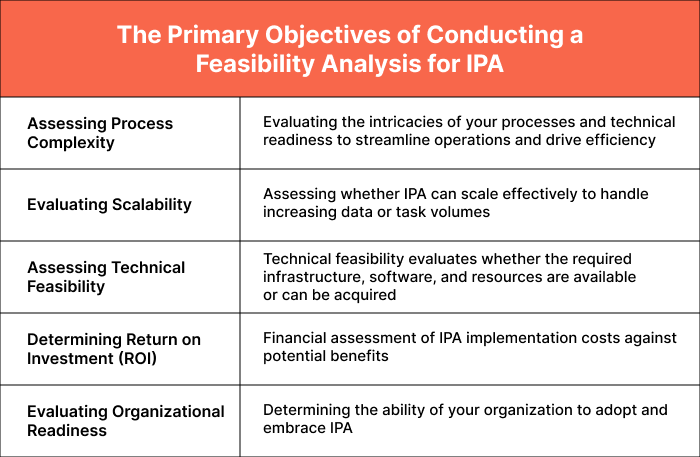Introduction
Welcome to the third blog in our series, “Unleashing the Power of Intelligent Process Automation: A Roadmap to Transform Your Business.” Previously, we discussed about identifying opportunities for Intelligent Process Automation (IPA) within your organization. This blog focuses on a critical aspect of this journey – feasibility analysis. Feasibility analysis goes beyond simply identifying processes that can be automated; it assesses the viability, compatibility, and potential return on investment of IPA for your organization.
Let’s embark on this analytical journey to make informed, data-driven decisions about IPA implementation.
Section 1: Understanding Feasibility Analysis
Feasibility analysis is crucial in evaluating the viability of implementing Intelligent Process Automation (IPA) within your organization. It is a systematic and data-driven approach to assess the potential benefits, challenges, and risks of adopting IPA. You can make informed decisions and ensure a successful automation journey by conducting a thorough feasibility analysis.
1.1 Defining Feasibility Analysis of IPA Implementation
Feasibility analysis is a process of evaluating the practicality and suitability of implementing IPA within your organization. It involves assessing various technical, financial, operational, and organizational factors to determine if IPA is the right solution for your unique business needs. The analysis aims to provide insights into IPA adoption’s potential benefits, challenges, and risks.
1.2 Objectives of Feasibility Analysis

1.3 Benefits of Conducting a Feasibility Analysis
Conducting a feasibility analysis offers the following key benefits:
- Informed Decision-Making: It provides comprehensive insights into the potential benefits of IPA solutions and challenges and risks involved in implementing the solution, enabling data-driven decisions aligned with your organization’s goals.
- Risk Mitigation: It identifies potential roadblocks upfront and helps develop mitigation strategies, ensuring a smoother transition to IPA with minimal disruptions.
- Cost Optimization: It assesses the financial implications of IPA implementation, comparing costs such as software licenses, infrastructure upgrades, training, and maintenance against expected benefits and savings, optimizing your investments.
- Alignment with Business Needs: Feasibility analysis determines if IPA aligns with your organization’s specific needs and identifies the most beneficial processes for automation, focusing your resources for maximum impact.

Section 2: Assessing Process Complexity
Assessing the complexity of your existing processes is crucial when considering IPA implementation.
2.1 Factors to Consider

The factors to consider include the number of decision points, variability, exceptions, and rule variations. Automating processes with numerous decision points can be challenging and may require advanced solutions.
- Number of Decision Points: Processes with multiple decision points require human judgment and decision-making. The complexity increases when decisions involve evaluating various factors, considering exceptions, and adapting to different scenarios.
- Variability: Processes that exhibit a high degree of variability, such as varying data formats, input sources, or user inputs, are complex processes that require more consideration. More standardized and consistent processes are more feasible to start with.
- Exceptions and Rule Variations: Processes involving numerous exceptions and rule variations are considered complex when automating. The ability to handle diverse scenarios and apply appropriate rules is essential to ensure accurate and reliable automation outcomes.
2.2 Examples and Scenarios
Let’s consider a few examples to understand how process complexity can influence the feasibility of automation:
Example 1: Loan Approval Process
In a loan approval process, decision points based on various factors, such as credit scores, income verification, and loan types, contribute to process complexity. The presence of multiple decision points and exceptions makes it a candidate for Intelligent Automation, and traditional automation won’t be feasible here.
Example 2: Invoice Processing
Invoice processing often involves diverse invoice formats, varying data fields, and exceptions, such as missing or incorrect information. These complexities make it perfect for IPA. While IPA can automate data extraction and validation for standardized invoices, handling non-standard formats or resolving exceptions may require human intervention.
Example 3: Email Automation
Consider a scenario where a company receives a high volume of customer emails that require prompt responses. The manual handling of emails results in delays, decreased productivity, and lower customer satisfaction.
The company can achieve remarkable improvements by implementing Intelligent Process Automation (IPA) for email automation. IPA can analyze incoming emails, categorize them based on predefined criteria, generate responses, and escalate urgent matters to the appropriate teams. This enables faster response times, increased productivity, and higher customer satisfaction.
Here’s a case study showing that implementing email automation through IPA reduces email response time from over 48 hours to just a few minutes, significantly improving productivity and CX.
In the above examples, the complexity of the processes influences the feasibility of full automation. It is essential to evaluate the extent to which IPA can handle decision points, variability, and exceptions within a process.
By assessing process complexity during the feasibility analysis, you can determine the feasibility of IPA implementation and identify areas where automation can be effectively applied. It helps set realistic expectations and ensures that the chosen automation solution aligns with the complexity of your processes.
Section 3: Evaluating Scalability
Scalability is crucial in assessing Intelligent Process Automation (IPA) feasibility, referring to the solution’s ability to handle increased volumes, frequencies, and growth.
3.1 Significance of Scalability
Scalability is key as organizational processes experience volume and frequency variations. Scalability ensures that your IPA solution can adapt to business needs as they evolve.
3.2 Scalability Considerations
- Volume: Assess if the automation can efficiently handle existing and increasing volumes.
- Frequency: Determine if the solution can handle the process consistently without interruptions.
- Anticipated Growth: Ensure the IPA solution can accommodate future growth and increased process requirements.
3.3 Scalability Challenges with IPA
IPA offers capabilities to tackle scalability challenges:
- Robust Infrastructure: IPA uses scalable infrastructures for seamless performance.
- Parallel Processing: IPA can parallelize tasks for faster execution and enhanced scalability.
- Elasticity: Cloud-based IPA solutions can scale resources based on demand.
- Process Design: Processes designed with scalability in mind can adapt to future growth without disruptions.
By evaluating scalability, organizations can ensure their automation solution can handle current volumes and anticipated growth, facilitating efficient process management.
Section 4: Analyzing Return on Investment (ROI)
ROI analysis is key in determining IPA feasibility. It assesses the financial benefits derived from automation.
4.1 Importance of Evaluating ROI
ROI evaluation provides a clear understanding of IPA’s financial impact and benefits, supporting informed decisions by comparing potential returns against implementation costs.
4.2 Factors to Consider in ROI Analysis

- Cost Reduction: Assess the potential savings achieved through IPA.
- Increased Productivity: Evaluate the impact of productivity levels.
- Enhanced Customer Satisfaction: Consider IPA’s potential impact on customer satisfaction.
4.3 Methods and Frameworks for ROI Analysis
To assess IPA’s ROI, organizations can use the following parameters:
- Cost-Benefit Analysis: Conduct a comprehensive cost-benefit analysis that compares the costs associated with IPA implementation to the anticipated benefits. This analysis helps understand the automation initiative’s financial feasibility and supports decision-making.
- Key Performance Indicators (KPIs): Define and track relevant KPIs that align with the expected benefits of automation. These KPIs could include metrics such as cost savings, process cycle time reduction, error rates, customer satisfaction scores, and productivity improvements. Measuring these KPIs provides a tangible way to quantify the returns on IPA implementation.
- Business Case Development: Build a strong business case for IPA implementation that outlines the expected ROI and justifies the investment. This case should include a comprehensive analysis of costs, benefits, and a realistic timeline for achieving the projected returns.
A thorough ROI analysis determines IPA’s financial viability and potential returns, underpinning decision-making, investment prioritization, and alignment with strategic business objectives.
Section 5: Technical and Organizational Readiness
Ensuring technical and organizational readiness is crucial for successfully implementing Intelligent Process Automation (IPA). This section will delve into the key aspects of technical and organizational readiness, highlighting their importance and providing strategies for a smooth and effective IPA implementation.
5.1 Technical Requirements and Infrastructure
Before embarking on an IPA journey, assessing the technical requirements and infrastructure necessary for successful implementation is essential. Consider the following factors:
- System Compatibility: Evaluate whether your existing systems and applications are compatible with IPA solutions. Identify any gaps or integration challenges that need to be addressed.
- Data Accessibility and Quality: Assess the availability and quality of data for automation. IPA relies on accurate and reliable data for decision-making and process execution. Determine if data sources are accessible and quality meets the required standards.
- Security and Compliance: Evaluate security protocols, data privacy policies, and frameworks to ensure that IPA implementation meets security and compliance standards.
- Scalability and Performance: Consider the scalability requirements of IPA. Assess whether your infrastructure can handle the increased workload and the growing demands of automation.
5.2 Organizational Readiness
Organizational readiness is vital for IPA implementation success.
- Change Management: Acknowledge that IPA implementation requires changes in processes and roles. Develop a strategy with clear communication, training, and stakeholder engagement to help employees adapt to changes.
- Stakeholder Buy-in: Secure support from key stakeholders early in the process. Engage them in decision-making and foster a shared vision for smooth IPA adoption.
- Skill Development: Identify skills gaps for IPA implementation and invest in training programs to equip employees. Encourage a learning culture for employees to leverage automation effectively.
- Governance and Process Ownership: Establish governance structures and define process ownership for accountability and continuous improvement. Set clear roles for managing IPA initiatives and mechanisms for ongoing review of automated processes.
5.3 Strategies and Best Practices

To ensure technical and organizational readiness, consider the following strategies and best practices:
- Pilot Projects: Begin with small-scale pilot projects to test and validate IPA’s technical feasibility and organizational readiness. Gather feedback, measure performance, and learn from the pilot initiatives to refine your approach before scaling up.
- Collaborative Approach: Foster collaboration among IT, operations, and business teams to ensure a holistic and cross-functional approach to IPA implementation. Involve all relevant stakeholders in decision-making, leveraging their expertise and insights to drive successful outcomes.
- Continuous Monitoring and Evaluation: Establish mechanisms for continuous monitoring and evaluation of IPA implementation. Regularly review key metrics, measure performance against expected outcomes, and make necessary adjustments to ensure ongoing success.
- Knowledge Sharing and Learning: Encourage sharing and learning across teams and departments. Establish communities of practice, conduct workshops, and facilitate the exchange of best practices and lessons learned. By fostering a culture of continuous adaptive learning and improvement, you can enhance the effectiveness of IPA implementation.
Organizations can set the stage for a successful IPA implementation by addressing technical requirements, infrastructure, and organizational readiness factors. Combining a robust technical foundation with effective change management, stakeholder buy-in, and skill development will pave the way for IPA’s smooth and efficient adoption.
Conclusion:
In conclusion, conducting a feasibility analysis is a critical step in determining the suitability of Intelligent Process Automation (IPA) for your business. By assessing process complexity, scalability, and return on investment and ensuring technical and organizational readiness, you can make informed decisions and set the stage for a successful IPA implementation.
We have explored the intricacies of feasibility analysis, understanding the importance of evaluating process complexity and scalability. We have also delved into the return on investment analysis, considering the financial benefits and customer-centric advantages that IPA can bring. Additionally, we highlighted the significance of technical and organizational readiness for a smooth implementation.
In the next blog of our series, “Building the Business Case for IPA,” we will look through the process of creating a compelling business case for IPA implementation. We will explore strategies for presenting the benefits, addressing challenges, and gaining support from key stakeholders. Stay tuned for practical insights and guidance on building a strong case for IPA.




